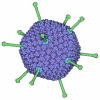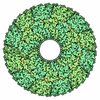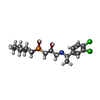[English] 日本語
 Yorodumi
Yorodumi- PDB-7cum: Cryo-EM structure of human GABA(B) receptor bound to the antagoni... -
+ Open data
Open data
- Basic information
Basic information
| Entry | Database: PDB / ID: 7cum | ||||||
|---|---|---|---|---|---|---|---|
| Title | Cryo-EM structure of human GABA(B) receptor bound to the antagonist CGP54626 | ||||||
 Components Components |
| ||||||
 Keywords Keywords | SIGNALING PROTEIN / GPCR / GABA / Neurosignalling / MEMBRANE PROTEIN | ||||||
| Function / homology |  Function and homology information Function and homology informationGABA B receptor activation / G protein-coupled GABA receptor complex / G protein-coupled neurotransmitter receptor activity involved in regulation of postsynaptic membrane potential / neuron-glial cell signaling / G protein-coupled neurotransmitter receptor activity involved in regulation of presynaptic membrane potential / G protein-coupled GABA receptor activity / G protein-coupled receptor heterodimeric complex / GABA receptor complex / negative regulation of adenylate cyclase activity / Class C/3 (Metabotropic glutamate/pheromone receptors) ...GABA B receptor activation / G protein-coupled GABA receptor complex / G protein-coupled neurotransmitter receptor activity involved in regulation of postsynaptic membrane potential / neuron-glial cell signaling / G protein-coupled neurotransmitter receptor activity involved in regulation of presynaptic membrane potential / G protein-coupled GABA receptor activity / G protein-coupled receptor heterodimeric complex / GABA receptor complex / negative regulation of adenylate cyclase activity / Class C/3 (Metabotropic glutamate/pheromone receptors) / gamma-aminobutyric acid signaling pathway / synaptic transmission, GABAergic / GABA-ergic synapse / adenylate cyclase-inhibiting G protein-coupled receptor signaling pathway / Schaffer collateral - CA1 synapse / Activation of G protein gated Potassium channels / Inhibition of voltage gated Ca2+ channels via Gbeta/gamma subunits / transmembrane signaling receptor activity / presynaptic membrane / G alpha (i) signalling events / chemical synaptic transmission / postsynaptic membrane / neuron projection / G protein-coupled receptor signaling pathway / protein heterodimerization activity / dendrite / extracellular region / plasma membrane / cytoplasm Similarity search - Function | ||||||
| Biological species |  Homo sapiens (human) Homo sapiens (human) | ||||||
| Method | ELECTRON MICROSCOPY / single particle reconstruction / cryo EM / Resolution: 3.52 Å | ||||||
 Authors Authors | Kim, Y. / Jeong, E. / Jeong, J. / Kim, Y. / Cho, Y. | ||||||
| Funding support |  Korea, Republic Of, 1items Korea, Republic Of, 1items
| ||||||
 Citation Citation |  Journal: J Mol Biol / Year: 2020 Journal: J Mol Biol / Year: 2020Title: Structural Basis for Activation of the Heterodimeric GABA Receptor. Authors: Yoojoong Kim / Eunyoung Jeong / Ji-Hong Jeong / Youngjin Kim / Yunje Cho /  Abstract: The neurotransmitter γ-aminobutyric acid (GABA) activates the metabotropic GABA receptor to generate slow, prolonged inhibitory signals that regulate the neural circuitry. The GABA receptor is an ...The neurotransmitter γ-aminobutyric acid (GABA) activates the metabotropic GABA receptor to generate slow, prolonged inhibitory signals that regulate the neural circuitry. The GABA receptor is an obligate heterodimeric G protein-coupled receptor (GPCR) comprised of GBR1 and GBR2 subunits, each with extracellular, seven-helix transmembrane (7TM), and coiled-coil domains. To understand how GABA-driven conformational changes in the extracellular domain are transmitted to the 7TM domain during signal transduction, we determined cryo-electron microscopy (EM) structures of GABA in two different states: an antagonist-bound inactive state, and an active state in which both the GABA agonist and a positive allosteric modulator (PAM) are bound. In the inactive state, the TM3 and TM5 helices in the two 7TM domains engage in cholesterol-mediated as well as direct interactions, resulting in an open conformation. GABA binding forces the extracellular domains of GBR1 and GBR2 into a compact form, relocating the linkers that connect the extracellular and 7TM domains closer to each other. The movement of the linker along with the associated extracellular loop 2 of the 7TM domain reorients the two 7TM domains and creates a new interface with the TM5, TM6 and TM7 helices in a closed conformation. PAM binding to the interface between the TM6 and TM6 helices stabilizes the active 7TM domain conformation. The relayed structural rearrangement results in significant conformational changes in the TM helices, as well as intracellular loop 3 in GBR2, which may promote the binding and activation of the Gi/o proteins. | ||||||
| History |
|
- Structure visualization
Structure visualization
| Movie |
 Movie viewer Movie viewer |
|---|---|
| Structure viewer | Molecule:  Molmil Molmil Jmol/JSmol Jmol/JSmol |
- Downloads & links
Downloads & links
- Download
Download
| PDBx/mmCIF format |  7cum.cif.gz 7cum.cif.gz | 487.7 KB | Display |  PDBx/mmCIF format PDBx/mmCIF format |
|---|---|---|---|---|
| PDB format |  pdb7cum.ent.gz pdb7cum.ent.gz | 399.8 KB | Display |  PDB format PDB format |
| PDBx/mmJSON format |  7cum.json.gz 7cum.json.gz | Tree view |  PDBx/mmJSON format PDBx/mmJSON format | |
| Others |  Other downloads Other downloads |
-Validation report
| Summary document |  7cum_validation.pdf.gz 7cum_validation.pdf.gz | 1.7 MB | Display |  wwPDB validaton report wwPDB validaton report |
|---|---|---|---|---|
| Full document |  7cum_full_validation.pdf.gz 7cum_full_validation.pdf.gz | 1.7 MB | Display | |
| Data in XML |  7cum_validation.xml.gz 7cum_validation.xml.gz | 43.9 KB | Display | |
| Data in CIF |  7cum_validation.cif.gz 7cum_validation.cif.gz | 65 KB | Display | |
| Arichive directory |  https://data.pdbj.org/pub/pdb/validation_reports/cu/7cum https://data.pdbj.org/pub/pdb/validation_reports/cu/7cum ftp://data.pdbj.org/pub/pdb/validation_reports/cu/7cum ftp://data.pdbj.org/pub/pdb/validation_reports/cu/7cum | HTTPS FTP |
-Related structure data
| Related structure data |  30472MC  7ca3C  7ca5C C: citing same article ( M: map data used to model this data |
|---|---|
| Similar structure data |
- Links
Links
- Assembly
Assembly
| Deposited unit | 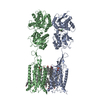
|
|---|---|
| 1 |
|
- Components
Components
| #1: Protein | Mass: 87248.195 Da / Num. of mol.: 1 Source method: isolated from a genetically manipulated source Source: (gene. exp.)  Homo sapiens (human) / Gene: GABBR1, GPRC3A / Production host: Homo sapiens (human) / Gene: GABBR1, GPRC3A / Production host:  Homo sapiens (human) / References: UniProt: Q9UBS5 Homo sapiens (human) / References: UniProt: Q9UBS5 | ||||||||
|---|---|---|---|---|---|---|---|---|---|
| #2: Protein | Mass: 92231.258 Da / Num. of mol.: 1 Source method: isolated from a genetically manipulated source Source: (gene. exp.)  Homo sapiens (human) / Gene: GABBR2, GPR51, GPRC3B / Production host: Homo sapiens (human) / Gene: GABBR2, GPR51, GPRC3B / Production host:  Homo sapiens (human) / References: UniProt: O75899 Homo sapiens (human) / References: UniProt: O75899 | ||||||||
| #3: Chemical | ChemComp-2BV / ( | ||||||||
| #4: Chemical | Mass: 814.167 Da / Num. of mol.: 2 / Source method: obtained synthetically / Feature type: SUBJECT OF INVESTIGATION #5: Chemical | ChemComp-CLR / Has ligand of interest | Y | Has protein modification | Y | Nonpolymer details | The phospholipid-like ligands are similar to U3G and U3D respectively but not exactly same. Since ...The phospholipid-like ligands are similar to U3G and U3D respectively but not exactly same. Since they were not characterized due to the unknown part, they are assigned with UNL. | |
-Experimental details
-Experiment
| Experiment | Method: ELECTRON MICROSCOPY |
|---|---|
| EM experiment | Aggregation state: PARTICLE / 3D reconstruction method: single particle reconstruction |
- Sample preparation
Sample preparation
| Component | Name: Gamma-aminobutyric acid type B receptor / Type: COMPLEX Details: Antagonist-bound Gamma-aminobutyric acid type B receptor Entity ID: #1-#2 / Source: RECOMBINANT |
|---|---|
| Molecular weight | Value: 200 kDa/nm / Experimental value: YES |
| Source (natural) | Organism:  Homo sapiens (human) Homo sapiens (human) |
| Source (recombinant) | Organism:  Homo sapiens (human) Homo sapiens (human) |
| Buffer solution | pH: 7.5 |
| Specimen | Embedding applied: NO / Shadowing applied: NO / Staining applied: NO / Vitrification applied: YES |
| Specimen support | Grid material: COPPER / Grid mesh size: 400 divisions/in. / Grid type: C-flat-1.2/1.3 |
| Vitrification | Cryogen name: ETHANE |
- Electron microscopy imaging
Electron microscopy imaging
| Experimental equipment |  Model: Titan Krios / Image courtesy: FEI Company | ||||||||||||
|---|---|---|---|---|---|---|---|---|---|---|---|---|---|
| Microscopy | Model: FEI TITAN KRIOS | ||||||||||||
| Electron gun | Electron source:  FIELD EMISSION GUN / Accelerating voltage: 300 kV / Illumination mode: FLOOD BEAM FIELD EMISSION GUN / Accelerating voltage: 300 kV / Illumination mode: FLOOD BEAM | ||||||||||||
| Electron lens | Mode: DIFFRACTION | ||||||||||||
| Image recording |
|
- Processing
Processing
| Software | Name: PHENIX / Version: 1.14_3260: / Classification: refinement | ||||||||||||||||||||||||
|---|---|---|---|---|---|---|---|---|---|---|---|---|---|---|---|---|---|---|---|---|---|---|---|---|---|
| CTF correction | Type: PHASE FLIPPING AND AMPLITUDE CORRECTION | ||||||||||||||||||||||||
| 3D reconstruction | Resolution: 3.52 Å / Resolution method: FSC 0.143 CUT-OFF / Num. of particles: 512675 / Symmetry type: POINT | ||||||||||||||||||||||||
| Refine LS restraints |
|
 Movie
Movie Controller
Controller








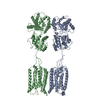
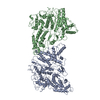

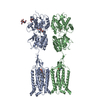
 PDBj
PDBj
